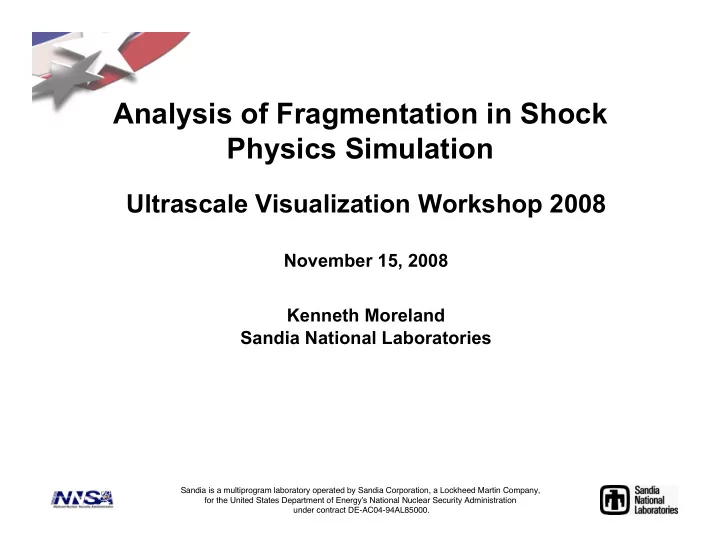

Analysis of Fragmentation in Shock Physics Simulation Ultrascale Visualization Workshop 2008 November 15, 2008 Kenneth Moreland Sandia National Laboratories Sandia is a multiprogram laboratory operated by Sandia Corporation, a Lockheed Martin Company, for the United States Department of Energy ʼ s National Nuclear Security Administration under contract DE-AC04-94AL85000.
An experiment is the partial knowledge of the full truth. A simulation is the full knowledge of a partial truth. Verification and Validation (V&V) brings these together.
The V of V&V • Verification compares simulations with known analytical solutions.
The Other V of V&V • Validation compares simulations with experiments. Simulation data near the end of the simulation, showing the complex distribution of Test data, showing shell fragments grouped fragments. Inset shows first frame of the simulation, in which a ball approaches a according to size. plate of the same material.
Identifying Fragments
Step 1: Fragment Connectivity 0.2 0.3 0.0 0.2 0.3 0.2 0.4 0.1 0.0 0.4 0.4 0.1 0.3 0.5 0.4 0.4 0.4 0.3 0.4 0.7 0.5 0.6 0.3 0.1 0.6 0.5 0.4 0.6 0.9 0.7 0.8 0.7 0.7 1.0 0.9 0.8 0.7 0.5 0.2 1.0 1.0 1.0 0.9 0.7 0.6
Step 1: Fragment Connectivity 0.2 0.3 0.0 0.2 0.3 0.2 0.4 0.1 0.0 0.4 0.4 0.1 0.3 0.5 0.4 0.4 0.4 0.3 0.4 0.7 0.5 0.6 0.3 0.1 0.6 0.5 0.4 0.6 0.9 0.7 0.8 0.7 0.7 1.0 0.9 0.8 0.7 0.5 0.2 1.0 1.0 1.0 0.9 0.7 0.6
Step 1: Fragment Connectivity 0.2 0.3 0.0 0.2 0.3 0.2 0.2 0.4 0.4 0.1 0.0 0.4 0.4 0.1 0.3 0.5 0.4 0.4 0.4 0.4 0.3 0.4 0.7 0.5 0.5 0.6 0.6 0.3 0.1 0.6 0.5 0.4 0.6 0.9 0.7 0.7 0.8 0.7 0.7 1.0 0.9 0.8 0.8 0.7 0.7 0.5 0.2 1.0 1.0 1.0 0.9 0.7 0.6 0.6
Step 1: Fragment Connectivity 0.2 0.3 0.0 0.2 0.3 0.2 0.2 0.4 0.4 0.1 0.0 0.4 0.4 0.1 0.3 0.5 0.4 0.4 0.4 0.4 0.3 0.4 0.7 0.5 0.5 0.6 0.6 0.3 0.1 0.6 0.5 0.4 0.6 0.9 0.7 0.7 0.8 0.7 0.7 1.0 0.9 0.8 0.8 0.7 0.7 0.5 0.2 1.0 1.0 1.0 0.9 0.7 0.6 0.6
Step 1: Fragment Connectivity 0.2 0.3 0.0 0.2 0.3 0.2 0.2 0.4 0.4 0.1 0.0 0.4 0.4 0.1 0.3 0.5 0.4 0.4 0.4 0.4 0.3 0.4 0.7 0.5 0.5 0.6 0.6 0.3 0.1 0.6 0.5 0.4 0.6 0.9 0.7 0.7 0.8 0.7 0.7 1.0 0.9 0.8 0.8 0.7 0.7 0.5 0.2 1.0 1.0 1.0 0.9 0.7 0.6 0.6
Step 1: Fragment Connectivity 0.2 0.3 0.0 0.2 0.3 0.2 0.2 0.4 0.4 0.1 0.0 0.4 0.4 0.1 0.3 0.5 0.4 0.4 0.4 0.4 0.3 0.4 0.7 0.5 0.5 0.6 0.6 0.3 0.1 0.6 0.5 0.4 0.6 0.9 0.7 0.7 0.8 0.7 0.7 1.0 0.9 0.8 0.8 0.7 0.7 0.5 0.2 1.0 1.0 1.0 0.9 0.7 0.6 0.6
Step 1: Fragment Connectivity 0.2 0.3 0.0 0.2 0.3 0.2 0.2 0.4 0.4 0.1 0.0 0.4 0.4 0.1 0.3 0.5 0.4 0.4 0.4 0.4 0.3 0.4 0.7 0.5 0.5 0.6 0.6 0.3 0.1 0.6 0.5 0.4 0.6 0.9 0.7 0.7 0.8 0.7 0.7 1.0 0.9 0.8 0.8 0.7 0.7 0.5 0.2 1.0 1.0 1.0 0.9 0.7 0.6 0.6
Step 1: Fragment Connectivity 0.2 0.3 0.0 0.2 0.3 0.2 0.2 0.4 0.4 0.1 0.0 0.4 0.4 0.1 0.3 0.5 0.4 0.4 0.4 0.4 0.3 0.4 0.7 0.5 0.5 0.6 0.6 0.3 0.1 0.6 0.5 0.4 0.6 0.9 0.7 0.7 0.8 0.7 0.7 1.0 0.9 0.8 0.8 0.7 0.7 0.5 0.2 1.0 1.0 1.0 0.9 0.7 0.6 0.6
Step 1: Fragment Connectivity 0.2 0.3 0.0 0.2 0.3 0.2 0.2 0.4 0.4 0.1 0.0 0.4 0.4 0.1 0.3 0.5 0.4 0.4 0.4 0.4 0.3 0.4 0.7 0.5 0.5 0.6 0.6 0.3 0.1 0.6 0.5 0.4 0.6 0.9 0.7 0.7 0.8 0.7 0.7 1.0 0.9 0.8 0.8 0.7 0.7 0.5 0.2 1.0 1.0 1.0 0.9 0.7 0.6 0.6
Step 2: Fragment Surfaces
Step 2: Fragment Surfaces
Step 2: Fragment Surfaces 0 1 2 3 4 5 6 7 8 9 10 11 12 13 14 15
Step 3: Smooth Surfaces
Step 4: Extract Field Quantities
Diagram of the Experiment Test article Fragments Witness plate
Corresponding Simulation
Corresponding Simulation
Corresponding Simulation
Redesigning the Shell
Further Analysis of Fragments
Drilling Down to Fragment Data
Drilling Down to Fragment Data The three heaviest fragments. The lightest fragments (with mass between 0.01 and 1 micrograms).
Average Field Values for Fragment Distributions
Intersection Queries
Intersection Queries
Current Work: Fragment Remeshing
Current Work: In-Situ Processing
Recommend
More recommend